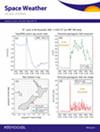PyIRI: Whole-Globe Approach to the International Reference Ionosphere Modeling Implemented in Python
IF 3.7
2区 地球科学
引用次数: 0
Abstract
The International Reference Ionosphere (IRI) model is widely used in the ionospheric community and considered the gold standard for empirical ionospheric models. The development of this model was initiated in the late 1960s using the FORTRAN language; for its programming approach, the model outputs were calculated separately for each given geographic location and time stamp. The Consultative Committee on International Radio (CCIR) and International Union of Radio Science (URSI) coefficients provide the skeleton of the IRI model, as they define the global distribution of the maximum useable ionospheric frequency foF2 and the propagation factor M(3,000)F2. At the U.S. Naval Research Laboratory, a novel Python tool was developed that enables global runs of the IRI model with significantly lower computational overhead. This was made possible through the Python rebuild of the core IRI component (which calculates ionospheric critical frequency using the CCIR or URSI coefficients), taking advantage of NumPy matrix multiplication instead of using cyclic addition. This paper explains in detail this new approach and introduces all components of the PyIRI package.PyIRI:用 Python 实现国际参考电离层建模的全局方法
国际参考电离层(IRI)模型在电离层界得到广泛应用,被认为是经验电离层模型的黄金标准。该模型的开发始于 20 世纪 60 年代末,使用的是 FORTRAN 语言;其编程方法是对每个给定的地理位置和时间戳分别计算模型输出。国际无线电咨询委员会(CCIR)和国际无线电科学联合会(URSI)的系数为 IRI 模型提供了骨架,因为它们定义了电离层最大可用频率 foF2 和传播因子 M(3,000)F2 的全球分布。美国海军研究实验室开发了一种新颖的 Python 工具,能够在全球范围内运行 IRI 模型,大大降低了计算开销。通过对 IRI 核心组件(使用 CCIR 或 URSI 系数计算电离层临界频率)进行 Python 重构,利用 NumPy 矩阵乘法而不是循环加法的优势,这一切成为可能。本文详细解释了这种新方法,并介绍了 PyIRI 软件包的所有组件。
本文章由计算机程序翻译,如有差异,请以英文原文为准。
求助全文
约1分钟内获得全文
求助全文

 求助内容:
求助内容: 应助结果提醒方式:
应助结果提醒方式:


